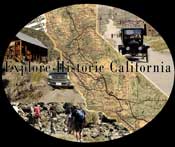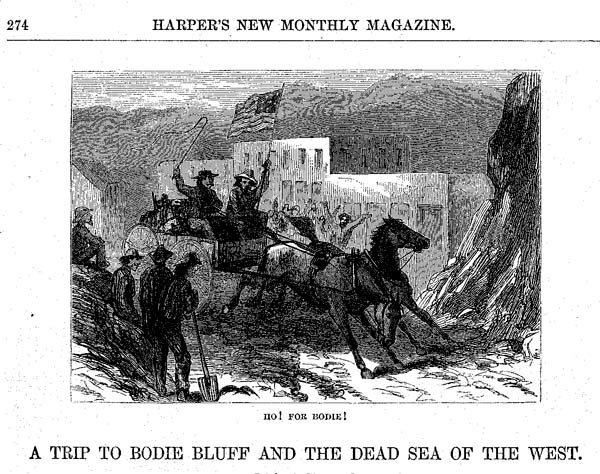 |
|
Opening sketch of Browne's "A Trip to Bodie Bluff"
appearing in Harper's New Monthly Magazine,
August, 1865. |
In the
early 1860’s, author J. (John) Ross Browne, magically
transported the Victorian reader to the booming mining towns
of Bodie and Aurora, and a trip to the salty Mono Lake in
the shadow of the Bodie Hills. His writings, reminiscent of
another noted traveling writer of the day, Mark Twain,
served to educate a nation thirsty for adventure and full of
curiosity of the workings and mineralogy of the famous
California and Nevada mines.
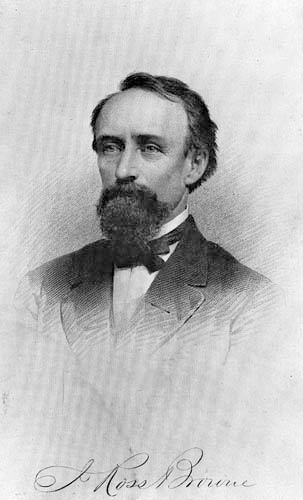 |
|
J.
Ross Browne |
Not
unlike Mark Twain, Browne was noted as a satirical
anecdotist, downplaying people and places. To the modern 21st
century reader, Twain and Browne, are often touted as
racist. However, it was a time when people of all races were
arriving in the mining camps in search of work, and it was a
time of racism in general. Both authors recorded what they
heard and saw in its raw colorful form, and to their credit,
gave their own Caucasian race equal hard time in it’s
peculiarities as well.
Most of
us are familiar with Mark Twain, his works, and his
background. J. Ross Browne is lesser known unless you have
wandered upon a copy of his minute 72 page book “A Trip
to Bodie Bluff and the Dead Sea of the West (Mono Lake) in
1863” in the Bodie museum book store, or are otherwise
familiar with his works for in antiquated editions of the
periodical Harper’s New Monthly Magazine.
Lest you
think from the previous paragraphs that Browne patterned
himself after Twain, it is here we point out that the
reverse is actually true. Twain’s book Roughing It
was originally published in 1872, consisting of similar
adventures, writing style, and artwork. Twain was working at
the Virginia City Territorial Enterprise when he ran
across Browne’s popular Harper’s New Monthly Magazine
sketches and articles on California, Nevada and Arizona. By
1866 the two were friends, and Twain was a guest in Browne’s
Oakland home.
Before we
embark upon the details of J. Ross Browne and who he was and
what he did, it is interesting to note that Mark Twain is
not the only author Brown is associated with. In the early
days of his writing career, he received notice from Edgar
Allen Poe, who published articles in his publication
Graham’s Lady’s and Gentlemen’s Magazine. It is also
said that Herman Melville wrote Moby Dick after
reading J. Ross Browne’s book on his experiences working on
a whaling ship.
It was on
February 11, 1821, in Dublin, Ireland when John Ross Browne
came into the world as the third child of Elizabeth Buck
Browne and Thomas Egerton Browne. Writing and politics must
have been etched in the young John Ross Browne’s genes, as
his father was a noted Irish journalist who edited three
newspapers and wrote editorials that eventually landed him
in jail. After three months, the older Browne’s sentence of
one hundred pounds and one year in jail was lifted upon
condition that he leave the country. The family chose to
sail from Ireland to America.
By 1833,
the Browne family found themselves in Louisville, Kentucky.
Thomas Browne pursued a career as a school teacher and went
on to continue his journalism career as owner and editor of
the Louisville Daily Reporter. J. Ross Browne was 11
years old. As he matured, he decided to sow his oats working
on the Ohio river flatboats, and Atlantic whalers,
eventually working as a newspaper reporter, efficient in
shorthand reporting. For a time he used the shorthand skills
as a reporter for the United States Senate. The experiences
he gained became subjects of his writings and books.
Browne
married the daughter of a Washington, D.C. physician, Lucy
Anna Mitchell, in 1844. During this time he began a career
in government, as private secretary to the Secretary of the
Treasury. A minor revenue service assignment sent him to
California in 1849 where it was his job to find a way to
keep sailors from ditching ship in the port of San Francisco
for the gold fields. At this time, he also surveyed the
postal routes from San Francisco to San Luis Obispo and
helped to establish post offices. When the (California)
Constitutional Convention of Monterey was held, he was asked
to record the minutes. Afterwards, he went back east to
visit his family and to publish the minutes. The minutes
proved a popular read, earning him $10,000.
Throughout his life, Browne traveled extensively in the
western United States, as well as Europe and the Holy Land.
These travels served as inspiration for his witty and
colorful books and articles for Harpers New Monthly
Magazine, as well as other popular journals of the day.
When he wasn’t traveling and writing he would continue his
dedication to government service, working as a special agent
to the Treasury Department, investigating fraud and
corruption in federal agencies. One assignment took him to
San Francisco in 1854, prompting him to bring the family to
Oakland and call it their permanent home.
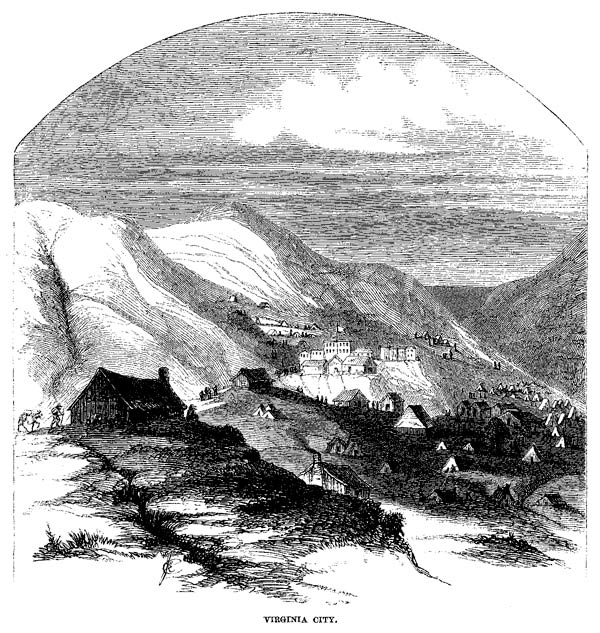 |
|
Browne's view of Virginia City, Nevada from
Harper's, January 1861. |
The
Nevada Comstock and Virginia City, called to Browne in 1860
resulting in a rather unflattering story A Peep at Washoe
followed two years later by Washoe Revisited in which
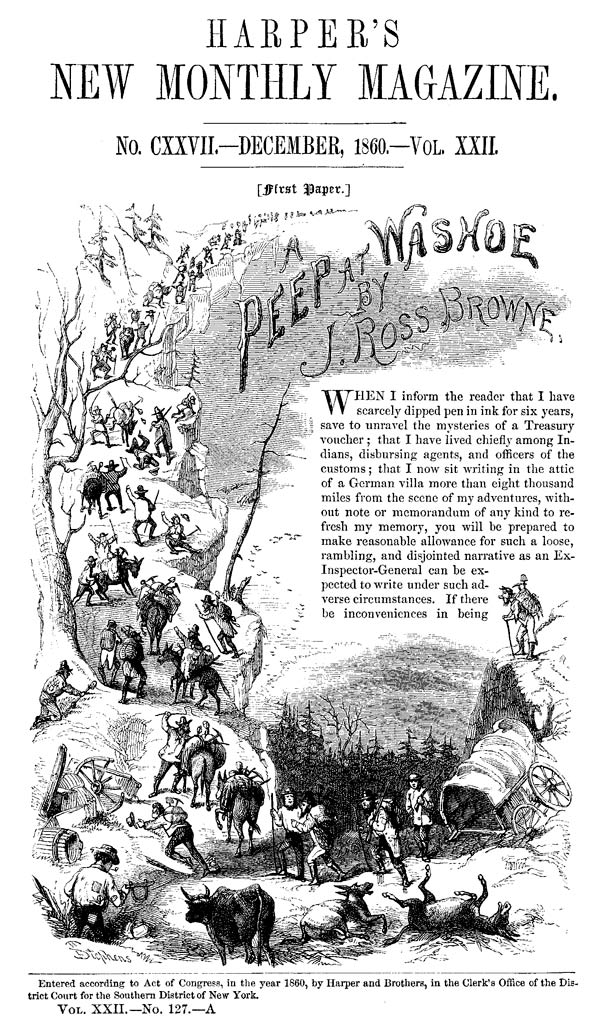 |
|
Browne's "A Peep at Washoe" appeared in Harper's
December, 1860 issue. |
he
observed a more maturing development in the same area. From
Virginia City, he found his way to Aurora, Nevada, which
became the opening lines of A Trip to Bodie Bluff:
“I had enjoyed to my heart’s content the amenities of social
life in Aurora; had a Sunday procession to the badger fight
of Mr. T. Jefferson Phelan, a high toned European; had
barely missed seeing a man shot dead in front of the Sazerac
Saloon for throwing brickbats at another man’s house…”
A
borrowed horse and buggy, driven by the lender, took J. Ross
Browne through the mine and mill, and cattle and hay ranch
valleys and canyons along the toll road from Aurora to Bodie
where he introduced his reader to the “primitive
habitations” of the lonely miner, and three days of
adventures:
“….it is a little remarkable that I am now alive to tell the
story of my adventures. I penetrated more shafts in the
earth, was dragged through more dangerous pits and holes in
wooden buckets, was forced to creep over more slippery
ledges, rich I mineral deposits, and to climb up a great
number of rickety ladders than I would like to undertake
again…”
The
written excursion showed up in Harper’s in 1865,
spurring the National Bureau of Mining to appoint Browne as
one of two commissioners. Although he had no specific
background in mining or geology, he declared:
“Although I do not claim to possess a scientific knowledge
of mining operations, or of the geological peculiarities of
these mineral districts, I have had so much practical
experience in the examination of mines that I do not fell
altogether incompetent to form a correct judgment on the
subject."
The
reports that resulted from this appointment educated the
general public about the western mining frontier. By
January 29, 1867 four slightly different editions of The
Mineral Resources (or Statistics) West of the Rocky Mountain
series had been printed. One thousand copies were ordered,
soon to be increased to 31,000 copies by February 25 of the
same year. The sales nearly matched those of Mark Twains
Roughing It. By 1875, 100,000 copies had been marketed
and sold.
Throughout his life of government service, J. Ross Browne
was noted as a man of integrity, loyalty, honesty and
efficiency. Following his appointment as commissioner of
mines, he served as United States Minister to China for a
year from 1868 to 1870. During this time he unearthed
practices he considered questionable from the previous
minister and was recalled from his position to return to the
United States unemployed.
In 1870,
settled in Oakland with his family, Browne, began
construction of a home which he dubbed Pagoda Hill. The
architecture was a mixture of Moorish, Chinese, Indian,
Italian and Russian with Gothic construction. His family was
clustered around him in houses of their own. Here he would
devote the rest of his life to literature, yet found time
for real estate and mining ventures.
J. Ross
Browne boarded a ferry boat to return home to Oakland from
San Francisco on December 9, 1875. Appendicitis struck, and
he was put up in a house with a friend on the Oakland
estuary. Browne died in the night at age 54.
|
 |
|
J.
Ross Browne self portrait. |
